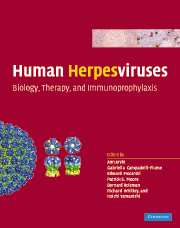12 results
Part I - Introduction: definition and classification of the human herpesviruses
-
-
- Book:
- Human Herpesviruses
- Published online:
- 24 December 2009
- Print publication:
- 16 August 2007, pp 1-2
-
- Chapter
- Export citation
Part II - Basic virology and viral gene effects on host cell functions: alphaherpesviruses
-
-
- Book:
- Human Herpesviruses
- Published online:
- 24 December 2009
- Print publication:
- 16 August 2007, pp 59-60
-
- Chapter
- Export citation
Contents
-
- Book:
- Human Herpesviruses
- Published online:
- 24 December 2009
- Print publication:
- 16 August 2007, pp v-viii
-
- Chapter
- Export citation
Plate section
-
- Book:
- Human Herpesviruses
- Published online:
- 24 December 2009
- Print publication:
- 16 August 2007, pp -
-
- Chapter
- Export citation
6 - Alphaherpes viral genes and their functions
- from Part II - Basic virology and viral gene effects on host cell functions: alphaherpesviruses
-
-
- Book:
- Human Herpesviruses
- Published online:
- 24 December 2009
- Print publication:
- 16 August 2007, pp 70-92
-
- Chapter
- Export citation
List of contributors
-
- Book:
- Human Herpesviruses
- Published online:
- 24 December 2009
- Print publication:
- 16 August 2007, pp ix-xviii
-
- Chapter
- Export citation
Part VIII - Herpes as therapeutic agents
-
-
- Book:
- Human Herpesviruses
- Published online:
- 24 December 2009
- Print publication:
- 16 August 2007, pp 1339-1340
-
- Chapter
- Export citation
Frontmatter
-
- Book:
- Human Herpesviruses
- Published online:
- 24 December 2009
- Print publication:
- 16 August 2007, pp i-iv
-
- Chapter
- Export citation
Preface
-
-
- Book:
- Human Herpesviruses
- Published online:
- 24 December 2009
- Print publication:
- 16 August 2007, pp xix-xx
-
- Chapter
- Export citation
13 - The strategy of herpes simplex virus replication and takeover of the host cell
- from Part II - Basic virology and viral gene effects on host cell functions: alphaherpesviruses
-
-
- Book:
- Human Herpesviruses
- Published online:
- 24 December 2009
- Print publication:
- 16 August 2007, pp 163-174
-
- Chapter
- Export citation
Index
-
- Book:
- Human Herpesviruses
- Published online:
- 24 December 2009
- Print publication:
- 16 August 2007, pp 1353-1388
-
- Chapter
- Export citation

Human Herpesviruses
- Biology, Therapy, and Immunoprophylaxis
-
- Published online:
- 24 December 2009
- Print publication:
- 16 August 2007



